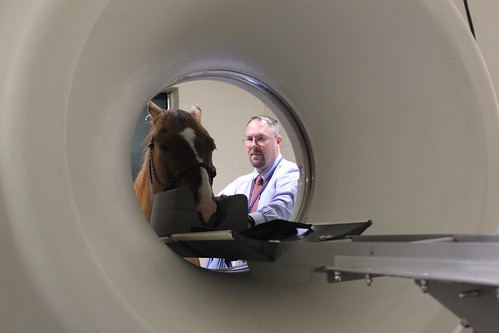College of Veterinary Medicine’s new equipment helps diagnose complex diseases in large animals
Article body
The Auburn University College of Veterinary Medicine's addition of a standing computerized tomography, or CT machine—one of a handful in the U.S.—is allowing veterinarians to more accurately diagnose and treat complex diseases in the necks and skulls of equine patients.
For radiology and equine faculty, this advanced diagnostic tool has already proven to make a significant difference in diagnosing and treating complicated diseases.
"The horse's head is an extremely complex anatomical structure," said Dr. Lindsey Boone, assistant professor of equine surgery. "A radiograph is a two-dimensional picture of what is going on in the head. With sinuses and teeth in particular, it can sometimes be difficult to identify exactly what is going on just from a radiograph.
"The CT adds to our diagnostic capabilities to know what's going on in the sinuses or what's going on with a tooth root," she said. "Those are the two most common scenarios."
Dr. Robert Cole, an assistant professor of radiology, said the concept behind standing CT was to "allow us to do cross-sectional imaging of the horse's head without having to go through anesthesia. That is the real the benefit.
"Without a CT machine, you are left with two options: make a diagnosis with radiographs, which can be challenging depending on the disease progress, or put the animal under general anesthesia, which means inserting IV catheters, withholding feed and postponing things for 24 hours. And while the risk is low, there is always some risk involved. If we can avoid that, all the better."
While the standing CT is limited to cross-sectional images of the skull and the upper part of the cervical spine, Cole said, "we have a fairly high caseload of referral surgeries for sinus diseases, and this gives us a way to image those and have a lot more information from baseline radiographs."
Cole said the machine is allowing surgeons to understand "exactly what is going on before the surgery takes place. Typically, on a lot of cases, a horse may present with a nasal discharge. We'd start with radiographs traditionally and we might see fluid in the sinus but we couldn't tell why it was there or the origin. The surgeon would go in and explore that sinus, not knowing exactly what they were getting into.
"With the standing CT, in the same amount of time or less, we can have that cross-sectional imaging and say 'here is exactly the boundary of this disease process and here is what the likely diagnosis would be.' The surgeon now knows exactly how to plan and knows what they are up against."
Boone said the new technology is being incorporated into the college's teaching mission. Senior-level students on clinical rotation will have the advantage of seeing firsthand how the machine helps radiology and equine faculty better diagnose problems.
"Being aware of extreme diagnostic modalities or those that can benefit our ability to know exactly what is going on is really important from a student perspective," she said. "Seeing a horse with skull radiographs and then seeing that horse get a CT, they will have a much better understanding of the anatomy of a horse head and have a better understanding of the disease processes."
Related Media
Media interested in this story can contact Communications Director Preston Sparks at (334) 844-9999 or preston.sparks@auburn.edu.
Auburn University is a nationally ranked land grant institution recognized for its commitment to world-class scholarship, interdisciplinary research with an elite, top-tier Carnegie R1 classification, life-changing outreach with Carnegie’s Community Engagement designation and an undergraduate education experience second to none. Auburn is home to more than 30,000 students, and its faculty and research partners collaborate to develop and deliver meaningful scholarship, science and technology-based advancements that meet pressing regional, national and global needs. Auburn’s commitment to active student engagement, professional success and public/private partnership drives a growing reputation for outreach and extension that delivers broad economic, health and societal impact.





